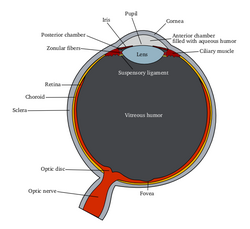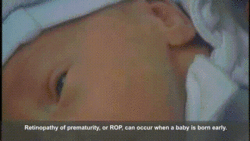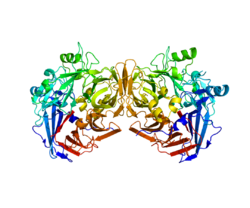Congenital Blindness Gene Therapy
Topic: Biology
 From HandWiki - Reading time: 3 min
From HandWiki - Reading time: 3 min
Congenital blindness refers to a group of diseases and conditions occurring in childhood or early adolescence of below 16 years old, which, if left untreated, result in blindness or severe visual impairment that are likely to be permanent blindness later in life.[1] Congenital blindness is a hereditary disease and can be cured by gene therapy. Visual loss in children or infant can occur either at the stage of prenatal (during the time of conception or intrauterine period) or postnatal stage (during birth).[2] A variety of causes can promote congenital blindness but the most concern and highest cause of it is a genetic mutation. 60% of congenital blindness are contributed from prenatal stage and another 40% are contributed from inherited disease.[3] However, most of the congenital blindness cases show that it can be avoidable or preventable with early treatment.[4]
Causes
Prenatal stage
- Premature Birth
- Refractive error[5]
- Congenital cataract[4]
- Retinopathy of prematurity (ROP)[1]
- Infection such as Ophtalmia neonatorum that happen during time of conception or intrauterine period[1]
- Vitamin A deficiency[1]
- Measles[5]
Postnatal stage
- Genetic mutation
The mutation can usually be an autosomal recessive condition and unusual condition of infant happened where it forms retinoblastoma result from autosomal dominant condition.[2] The mutation of Retinal pigment epithelium-specific 65 kDa protein (RPE65) gene which function to produce retinoid isomerohydrolase which is an enzyme. RPE65 performs a key role in the trans-cis isomerization of retinol in the retinal pigment epithelium of the eye. The palmitoylation of RPE65 serves to switch off the visual cycle in darkness and to switch it on in the light. Mutation in this gene causing disorder of phototransduction pathway through brain which detect light fail to function.[6]
Diagnosis
Paediatric nurses, medical officers and paediatricians trained in eye screening could detect small or large eyeballs, nystagmus, strabismus, “white pupils” and birth defects like coloboma and aniridia.[1] For pregnant women from family with history of congenital blindness will be closely monitor and need to carry out genetic test in order to identify is there mutation occur or not.
Gene therapy treatment
Gene therapy treatment is done as an outpatient. Patients come to the hospital for the treatment, then return home. Patients do not need to be monitored strictly or stay in the hospital. The gene therapy treatment is in vivo which involves the use of a delivery vector to transmit the therapeutic gene into the targeted cells. The delivery vector uses a recombinant adeno-associated virus (AAV) carrying the RPE65 gene (AAV2-hRPE65v2).[7][8] The procedure is a single injection of the AAV2-hRPE65v2 therapeutic gene into the unilateral subretinal of the eye.[8] Gene therapy can only improve eye vision, but cannot cure the condition. The therapeutic gene, Voretigene neparvovec (Luxturna) , was the first gene therapy approved by FDA for inherited diseases.[9]
References
- ↑ 1.0 1.1 1.2 1.3 1.4 Khandekar, Rajiv (2008). "Visual Disabilities in Children Including Childhood Blindness". Middle East African Journal of Ophthalmology 15 (3): 129–134. doi:10.4103/0974-9233.51988. ISSN 0974-9233. PMID 21369469.
- ↑ 2.0 2.1 Gogate, Parikshit; Gilbert, Clare; Zin, Andrea (2011). "Severe Visual Impairment and Blindness in Infants: Causes and Opportunities for Control". Middle East African Journal of Ophthalmology 18 (2): 109–114. doi:10.4103/0974-9233.80698. ISSN 0974-9233. PMID 21731320.
- ↑ "Genetic Eye Disorders & Blindness Causes | Cleveland Clinic: Health Library" (in en). https://my.clevelandclinic.org/health/diseases/17130-inherited-eye-disease.
- ↑ 4.0 4.1 Yorston, D. (1999). "The global initiative vison 2020: the right to sight childhood blindness". Community Eye Health 12 (31): 44–45. ISSN 0953-6833. PMID 17491999.
- ↑ 5.0 5.1 Gilbert, Clare; Muhit, Mohammed (2008). "Twenty years of childhood blindness: what have we learnt?". Community Eye Health 21 (67): 46–47. ISSN 0953-6833. PMID 19030129.
- ↑ Wolf, George (2005). "Function of the protein RPE65 in the visual cycle". Nutrition Reviews 63 (3): 97–100. doi:10.1111/j.1753-4887.2005.tb00127.x. ISSN 0029-6643. PMID 15825812.
- ↑ the Adeno-associated virus (AAV) carrying the RPE65 gene (AAV2-hRPE65v2)
- ↑ 8.0 8.1 Maguire, Albert M.; High, Katherine A.; Mingozzi, Federico; Shindler, Kenneth S.; Simonelli, Francesca; Auricchio, Alberto; Wright, J. Fraser; Sun, Junwei et al. (8 February 2012). "AAV2 Gene Therapy Readministration in Three Adults with Congenital Blindness" (in en). Science Translational Medicine 4 (120): 120ra15. doi:10.1126/scitranslmed.3002865. ISSN 1946-6234. PMID 22323828.
- ↑ McGinley, Laurie. "FDA approves first gene therapy for an inherited disease." (in en). Washington Post. https://www.washingtonpost.com/news/to-your-health/wp/2017/12/18/fda-approves-first-gene-therapy-for-an-inherited-disease-childhood-blindness/. Retrieved 19 December 2017.
 KSF
KSF


